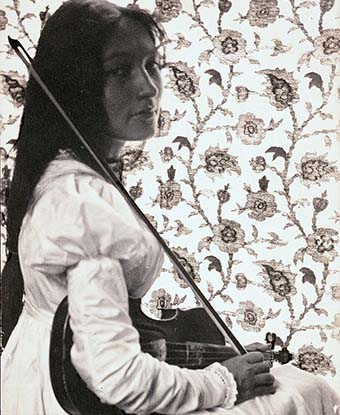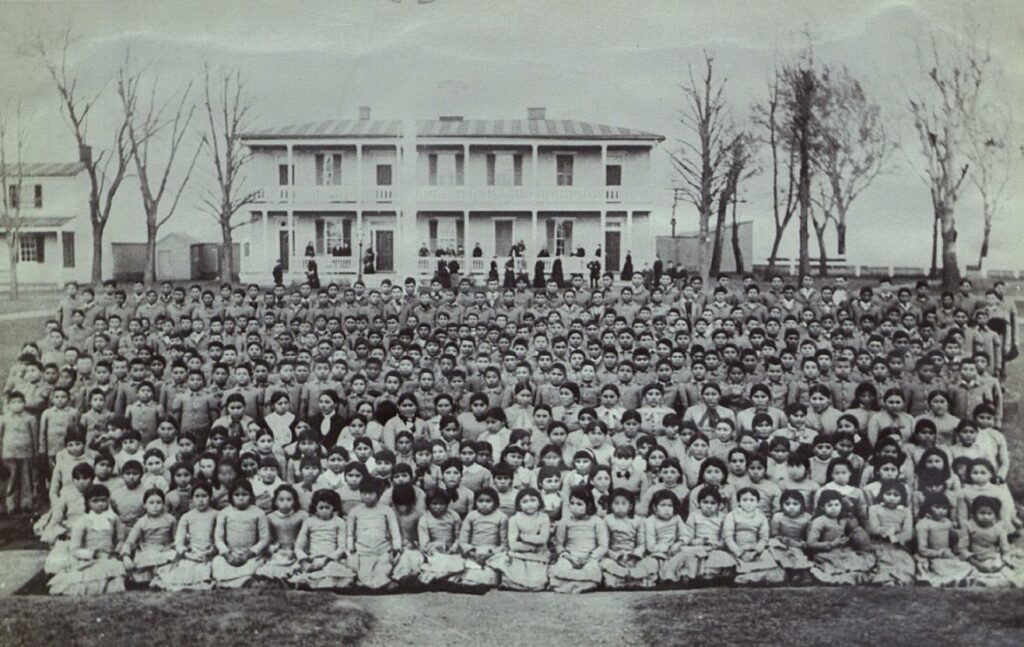
I was neither a wee girl nor a tall one ; neither a wild Indian nor a tame one. This deplorable situation was the effect of my brief course in the East, and the unsatisfactory “ teenth ” in a girl’s years.
(Zitkala-ŠA,191))
Zitkala-Ša (Gertrude Simmons Bonnin) was born in 1876, on the Pine Ridge Reservation in South Dakota. Her father was a (white) man named William Felker, who abandoned the family before Zitkala-Ša was born and her mother was Ellen Tate Iyohinwin Simmons, a Yankton-Dakota woman. Zitkala-Ša grew up in a purely Indian environment. At the age of eight she left the reservation to attend the White’s Manual Labor Institute, a missionary boarding school located in Wabash, Indiana. Michael Coleman characterises the feelings of Native American children attending these schools with: „Ignorant of English and with emotions and motivations ranging from obedience to fear to curiosity to desires for white goods and an easier life, they set off into an almost totally alien world.“ (31) Donna L. Akers argues that “ […] these schools sought to destroy Indigenous ways of life, belief systems, languages, and spiritual practices by removing Indigenous children from their families and homes […] After four years of education she went back to the Pine Ridge Reservation. After her graduation she decided to attend Earlham College in Richmond, Indiana where she started to write and take part in oratorical contests. In the following years of her life she taught music to children, wrote articles in numerous magazines and was politically active. She was the secretary of the Society of American Indians (SAI) and corresponded with the Bureau of Indian Affairs (BIA) which she often criticised. With this work she tried to help Indian Americans to regain their rights to their cultural and tribal identity. Zitkala-Ša lived in a time, where native land was stolen, native people died of starvation and sickness due to American policies regarding natives and discrimination was still widespread through the country. Zitkala-Ša died on January 26, 1938, in Washington, D.C.
The following Chapter of this blog entry will take a closer look at „Four strange summers“ from the article „The School Days of an Indian Girl published in February, 1900. The analysis will be about the inner-conflict of Zitkala-Ša regarding her national identity. This inner conflict is about her struggle to identify with neither American culture nor Indian culture, making her an outcast to both. This is the result of the attempt to civilise Indian people and their cultures.
When cultures compete within
“ During this time I seemed to hang in the heart of chaos, beyond the touch or voice of human aid.“
(Zitkala-Ša, 191)

This chapter is riddled with passages that describe a deep inner-conflict of her national identity. Zitkala-Ša calls it „hang[ing] in the heart of chaos“ (…) where no one could help her. Her family can’t quite understand her problems, because her brother is ten years older than her and her mother was never inside of a boarding school. Dexter Fisher goes even further and argues that her relatives were „highly suspect of her“ (230) „In their minds she had abandoned […] the Indian way of life by getting an education in the white man’s world.“ (Fisher,230) She goes on to say that „even nature seemed to have no place for me“ (Zitkala-Ša, 191). This is an important note because nature was sacred to native Americans because they believed that they „were inseparable from their lands“ (Akers, 61) and connected to nature as deeply as to their tribe. This can be traced back to her time at the boarding school. There she had to work everyday under hard conditions, agonising rules and punishment. Akers describes this very fitting: „This regimented control was the antithesis of the rhythms of the natural world that had formerly shaped their lives.“ (Akers, 74) Zitkala-Ša even says in the text, that this situation is due to her „brief course in the East […] (Zitkala-Ša, 191) Even when she rides her brothers pony she feels unsatisfied. She calls her riding „insignificant“ and „reckless“ (Zitkala-Ša ,191) When reading this passage it seems like Zitkala-Sa wants to break free and re-connect to her cultural roots.
After she stops riding she states that „there was an unrest gnawing at my heart“ (Zitkala-Ša,191). After being told by her brother that she can’t attend a party with him and seeing other young people who attended school she cries and calls out her differences to these people. That they were „no more young braves in blankets […] nor Indian maids with pretty painted cheeks.“ (Zitkala-Ša,191) She describes their „civilised“ clothing, that they talk in English and that she can’t seem to fit in . Sandra Kumamoto Stanley states: “ […] she realizes that she no longer belongs in either her mother’s or the missionary’s world. Caught between both cultures, she must face the fact that she is a representative of both the ethnographic self and the radical other. (67) When she sobs by her mother she hands her the bible, the „white-mans papers“. In the text she expresses her will to burn the book and describes herself as „enraged“. She can’t find find identification in a book she was forced to read from a culture which is forced upon her. But because she is not accepted in either her family nor the „white-mans world“ she is in a „constant conflict between tradition and acculturation“ (Fisher, 231)
Later in the text Zitkala-Ša hears her mother crying and calling for help from her brothers spirits. She is crying because her daughter has this inner-conflict, that she can’t find balance in an Indian way of life. Evidence for this is, that Zitkala-Ša, after she had left for college, „never was reconciled with her mother.“ (Fisher, 233) To conclude this analysis one could argue like Deborah Welsh that Zitkala-Ša felt „pulled toward the Anglo world.“ (8), because of her decision to go to college or learn the violin, but this is not entirely on her. The emergence of this „pull“ was the try to „kill the Indian, save the man“, the motto of Richard Henry Pratt, the founder of the system „boarding school“. This try created confused children with inner-conflicts of competing cultures. But not even this stopped Zitkala-Ša from excelling in music, art but most importantly in her work as an activist. A quote from Donna L. Akers will be a great closing argument for this blog entry. „But the US desire to “kill the Indian, save the man,” did not succeed completely, as Indigenous people struggled to maintain and transmit their distinct world views and belief systems. Indigenous peoples have spent decades rebuilding their languages, decolonizing their histories, and reviving the valuable cultural heritage that the United States sought to destroy.“ (77)
Bibliography and Sources
Akers, Donna L. “Indigenous Nations and the United States.” The Cambridge History of America and the World: Volume 2: 1812– 1900, edited by Jay Sexton and Kristin Hoganson, vol. 2, Cambridge University Press, 2022, pp. 60–79. https:// doi.org/10.1017/9781108297479.004. Accessed 19 May 2022
Fisher, Dexter. “Zitkala Sa: The Evolution of a Writer.” American Indian Quarterly, vol. 5, no. 3, 1979, pp. 229–38. JSTOR, https://doi.org/10.2307/1183520. Accessed 29 May 2022.
Henderson, Melessa Renee, Curtright, Lauren. Gertrude Bonnin Zitkala-Ša. Voices from the Gaps, University of Minnesota Digital Conservancy, 1997 https://hdl.handle.net/11299/166100. Accessed 19 May 2022.
Stanley, Sandra Kumamoto. “Claiming a Native American Identity: Zitkala-Sa and Autobiographical Strategies.” Pacific Coast Philology, vol. 29, no. 1, 1994, pp. 64–69. JSTOR, https://doi.org/10.2307/1316348. Accessed 29 May 2022.
Susag, Dorothea M. “Zitkala-Sa (Gertrude Simmons Bonnin): A Power(Full) Literary Voice.” Studies in American Indian Literatures, vol. 5, no. 4, 1993, pp. 3–24. JSTOR, http://www.jstor.org/stable/20736763. Accessed 29 May 2022.
Zitkala-S͏̈a. The School Days of an Indian Girl / Zitkala-Sa. University of Virginia Library, 1996, pp. 191-192 EBSCOhost, https://search.ebscohost.com/login.aspx?direct=true&db=cat07899a&AN=ulb.097224081&lang=de&site=eds-live&scope=site. Accessed 29 May 2022.
Sources for Pictures
https://www.google.com/url?sa=i&url=https%3A%2F%2Fstorymaps.arcgis.com%2Fstories%2F0841041e6daa4427be5d70aac9dab547&psig=AOvVaw1AO2uA4SzWM0thZC9-aKes&ust=1653942363514000&source=images&cd=vfe&ved=0CAwQjRxqFwoTCOi489DFhfgCFQAAAAAdAAAAABAI
https://www.google.com/url?sa=i&url=https%3A%2F%2Fwww.nps.gov%2Fpeople%2Fzitkala-sa.htm&psig=AOvVaw2B-7jMxglJ9orfV5AALyXk&ust=1653942477650000&source=images&cd=vfe&ved=0CAwQjRxqFwoTCKDt_YHGhfgCFQAAAAAdAAAAABAD